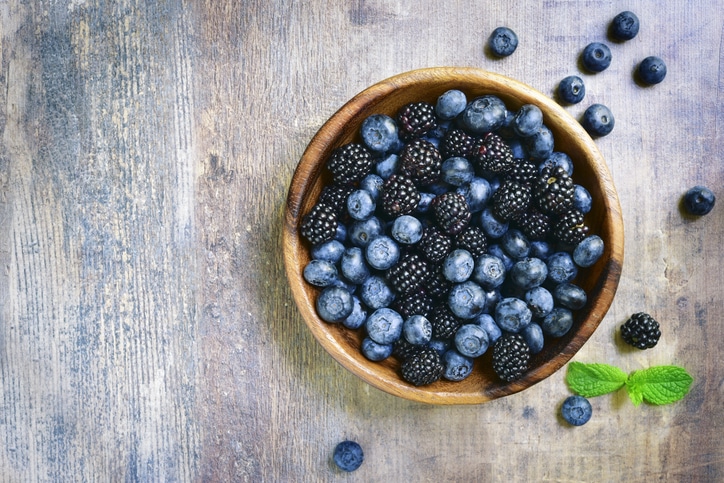
Eating nutrient-dense foods can make it easier for people to manage diabetes. Get all the information you need on the concept of nutrient density from ADS.

Written by: ADS Staff
Clinically Reviewed by: Halle Elbling, MS, RDN, CDCES
Most people know that foods like fresh produce and lean meats are healthier than fried foods and soft drinks, but you may not know why that’s the case. Many of the health benefits these foods deliver are tied to a concept known as “nutrient density.”
While anyone can benefit from eating nutritionally dense foods, these foods can be especially helpful for people with diabetes. If you make a point of eating foods with high nutrient density, you can get the nutrients you need while lowering your risk of hyperglycemia. Here, you’ll find ADS’ complete guide to nutrient density and a list of nutrient-dense foods that can seriously improve your diabetes nutrition strategy.
Table of Contents
- Nutrient Density 101
- 10 Nutrient Dense Foods You’ll Love
- ANDI Scoring
- Nutrient-Dense Food Vs Calorie Dense Foods
- Diabetes Supplies with ADS
- FAQs
- Bonus Quiz
Nutrient Density 101
Before you start adding nutrient-dense foods to your diabetes diet, you’ll want to have a basic understanding of this concept. To do that, let’s answer two simple questions:
What Does “Nutrient Density” Mean?

Since you can only eat a certain amount of food in a given day, the type of food you eat matters. To add the right food items to your diet, you’ll need to consider more than just calories.
Even if they have the same amount of calories, different foods can contain varied amounts of nutrients such as vitamins and minerals. Thus, the phrase “nutrient density” describes the nutritional content a given food item delivers compared to its calorie count.
What Are Nutrient-Dense Foods?
As you might expect, nutrient-dense foods are simply foods that have high nutrient density. These health foods contain vitamins, minerals, and other nutrients while having relatively low calories.
Though the health benefits associated with nutrient-dense foods aren’t exclusive to people with diabetes, they can make it easier to keep diabetes symptoms like high blood sugar in check. A diet packed with nutrient-rich foods can also reduce people with prediabetes’ risk of developing type 2 diabetes.
Add These Superfoods to Your Diet
Before you make any changes to your diabetes diet, your first step should be to talk to your healthcare team. As part of that discussion, you’ll want to consider the most nutrient-dense foods available today, such as:
Leafy Greens
Generally speaking, leafy greens are rich in nutrients and great for diabetes management. One of the best options in this category is kale—this vegetable is chock-full of fiber, vitamins, minerals, antioxidants, and beneficial bioactive compounds.
Kale is also high in vitamins C, A, K1, and B6, and it contains large amounts of calcium, potassium, magnesium, manganese, and copper. Best of all, a one-cup serving of kale includes just nine calories.
Other nutrient-rich leafy greens worth adding to your diabetes diet include:
- Collard greens. Along with being an excellent source of vitamin K, collard greens can help you get calcium and vitamins A, B9, and C.
- Watercress. When you eat a cup of raw watercress, you’ll get 71 percent of your daily value (DV) for vitamin K, 17 percent of your DV for vitamin C, and six percent of your DV for vitamin A.
- Spinach. Eating spinach is a fantastic way to boost your intake of vitamins A and K, manganese, and folate.
- Swiss chard. This veggie includes a flavonoid known as “syringic acid,” which might help people lower their blood glucose levels.
- Arugula. A single cup of raw arugula includes five percent of your DV for folate, three percent of your DV for vitamins A and C, and 18 percent of your DV for vitamin K.

Berries
Many items in the produce section are great for your health, but few fruits can match blueberries in terms of sheer nutritional value. Though vegetables often have higher levels of vitamins and minerals, these berries make up for that with the antioxidants they contain.
Some of these antioxidants can cross the blood-brain barrier, allowing them to protect your brain—studies show that blueberries may boost memory in older people. In another study, blueberries appeared to help obese individuals with metabolic syndrome lower their LDL (or “bad”) cholesterol levels. These berries could play a role in fighting cancer, too.
Of course, blueberries aren’t the only berries that pack a nutritional wallop. You can also get antioxidants and other nutrients from strawberries, acai berries, goji berries, and mulberries.
Garlic
Garlic can do much more than add flavor to your meals. When you make garlic a part of your diet, you’ll benefit from its high levels of calcium, manganese, selenium, copper, potassium, and vitamins C, B1, and B6.
Meanwhile, garlic contains sulfur compounds like allicin, which could lower your blood pressure and LDL cholesterol. As if that wasn’t enough, studies show that garlic also has various cancer-fighting properties.
Beans and Peas
Beans are delicious, affordable, and packed with nutrients. These nutritionally dense foods can help you manage your blood sugar while giving you lots of fiber, protein, iron, zinc, and folate:
- Kidney beans
- Pinto beans
- Garbanzo beans
- Lima beans
- Black beans
- Black-eyed peas
- Split peas
Fish

You might have heard that fish is an ideal source of protein for diabetes patients. While that doesn’t mean that all fish are equally nutritious, eating some types of fish at least once or twice a week can promote good health.
Salmon is an excellent seafood option in terms of nutrition density—this type of fish is exceptionally high in heart-healthy omega-3 fatty acids. Adding salmon to your diet will also give you B vitamins, potassium, magnesium, and selenium while reducing your risk of certain serious diseases.
Sardines are another type of fish that come packed with omega-3s. They’re also a uniquely nutrient-rich option because they’re customarily eaten whole (including their organs). That means sardines offer small amounts of almost every nutrient you could need.
However, you should exercise caution when purchasing sardines, as canned sardines are often high in sodium. Instead, try to find water-packed sardines with packaging that includes the term “low sodium.”
Dark Chocolate
Living with diabetes doesn’t have to mean giving up dessert—especially when you treat your sweet tooth to dark chocolate! Assuming it has a high cocoa percentage and you consume it in moderation, dark chocolate can be far more nutritious than you might think. In fact, studies have shown that dark chocolate is among the most antioxidant-rich foods in the world.
Dark chocolate has health benefits resembling those associated with blueberry consumption. Research also suggests that eating this type of chocolate at least five times a week could reduce your heart disease risk by 57 percent.
All About ANDI Scoring
When you’re looking for new nutrient-dense foods to add to your diet, you may want to consider using the Aggregate Nutrient Density Index (ANDI). This scoring system is meant to help people find the most nutrient-dense foods on the market.
In the ANDI scoring system, foods can get a score that falls anywhere from 1 to 1,000—the higher a food’s score, the more nutrient-dense it is. Here’s where some well-known food items fall on this scale:
| Food Item | ANDI Score |
| Kale | 1,000 |
| Collard greens | 1,000 |
| Watercress | 1,000 |
| Swiss chard | 895 |
| Arugula | 604 |
| Blueberries | 132 |
| Kidney beans | 64 |
| Salmon | 34 |
| Cola | 1 |
It’s important to note that the ANDI system isn’t perfect; as you can see, superfoods like blueberries and salmon have surprisingly low ANDI scores. Still, this system can help people with diabetes find healthy foods to add to their diets and get a rough idea of the nutrient density these foods have to offer.
Nutrient-Dense Foods vs. Calorie-Dense Foods: What’s the Difference?
When you’re doing research on nutrient density, you may run into the term “calorie-dense foods.” But while these phrases may sound similar, the concepts they describe are extremely different.
Calorie-dense foods are food items that are full of calories and which offer relatively low nutritional value. As a result, this phrase is effectively a synonym for “junk food”—and that means calorie-dense foods should never be a significant part of your diabetes diet.
Some well-known examples of calorie-dense food (and more nutrient-dense alternatives) include:
| Calorie-Dense Foods | Nutrient-Dense Foods |
| Cookies, cakes, and candy | Dark chocolate |
| Potato chips | Nuts and seeds |
| White bread | Whole-grain bread |
| Processed meats | Fish rich in omega-3 fatty acids |
Support Your Nutrient-Dense Diet With Diabetes Supplies
Eating a diabetes diet rich in nutrient-dense foods is a great way to manage diabetes. However, you’ll still need to closely monitor your glucose levels to ensure these health foods are giving you the benefits you’d expect.
To do that, you’ll need to use glucose meters, CGM systems, and diabetes testing supplies. At ADS, we offer all of these diabetes supplies and more—and thanks to our exceptional turnaround times, your order will arrive before you know it. Take a look at the supplies we have in stock today!
Frequently Asked Questions
What Foods Are High in Nutrients?
If you’re trying to add nutrient-dense foods to your diet, you have a wide range of options. Beans and peas, leafy greens, and berries are just a few of the many foods included in this category.
What Is The Most Nutrient-Dense Food Ever?
While some foods have higher nutrient density than others, no food item can provide 100 percent of the nutrients you need on its own. Because of that, you should eat a wide range of nutrient-rich foods instead of focusing on a single superfood.
What Food Can Diabetics Eat Freely?
The nutrient-rich foods included in this article are all excellent additions to a diabetes diet, but they aren’t necessarily “free foods” (that is, foods with less than 20 calories or 5 grams of carbs per serving). Truly free foods for people with diabetes include carbonated water, a cup of raw cabbage or cucumber, a half-cup of unsweetened cranberries, and hard sugar-free candy.
Bonus Quiz: Healthy Eating Habits: Fact or Fiction?
1. A healthy eating style includes a limited number of foods.
FICTION: A variety of nutritious foods from all of the food groups can make up a healthy eating style. Visit ChooseMyPlate.gov for more information.
2. Vegetable oils are an appropriate substitute for solid fats.
FACT: Solid fats have higher amounts of saturated fat and/or trans fats, which may increase the risk of heart disease. In comparison, oils provide more unsaturated fats, which are healthier.
3. Physical activity must be done for at least 10 minutes for it to be considered beneficial as a form of exercise.
FICTION: Although there are additional health benefits with increased physical activity, all activity counts so make a goal to move more throughout the day. For more information, check out the Move Your Way website at: https://health.gov/moveyourway/.
4. Portion sizes and serving sizes are the same things.
FICTION: A portion an amount you choose to eat or drink; whereas a serving size is used as a reference for what counts as a serving from one of the MyPlate food groups or the amount indicated on a Nutrition Facts label.
5. It is recommended that calories from added sugars be limited to less than 10% of calories per day.
FACT: Include healthier choices from the MyPlate food groups in place of foods and drinks with added sugars to better meet your nutrient needs.
6. Most Americans get enough dietary fiber on a daily basis.
FICTION: It is estimated that most people in the U.S. only consume half of the recommended amount of dietary fiber daily. Good sources include fruits, vegetables, and whole grains.
7. Everyone needs the same number of calories, which is 2,000 calories per day.
FICTION: Although 2,000 calories per day can be found on the Nutrition Facts label and on menus, this is only used for general advice. Visit ChooseMyPlate.gov to create a MyPlate Plan, which includes food group targets based on your individual calorie needs or meet with a registered dietitian nutritionist for personalized nutrition guidance.
